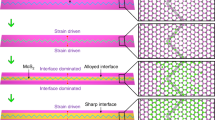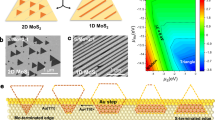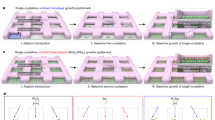Abstract
Two-dimensional (2D) materials are among the most promising candidates for next-generation electronics due to their atomic thinness, allowing for flexible transparent electronics and ultimate length scaling1. Thus far, atomically thin p–n junctions2,3,4,5,6,7,8, metal–semiconductor contacts9,10,11, and metal–insulator barriers12,13,14 have been demonstrated. Although 2D materials achieve the thinnest possible devices, precise nanoscale control over the lateral dimensions is also necessary. Here, we report the direct synthesis of sub-nanometre-wide one-dimensional (1D) MoS2 channels embedded within WSe2 monolayers, using a dislocation-catalysed approach. The 1D channels have edges free of misfit dislocations and dangling bonds, forming a coherent interface with the embedding 2D matrix. Periodic dislocation arrays produce 2D superlattices of coherent MoS2 1D channels in WSe2. Using molecular dynamics simulations, we have identified other combinations of 2D materials where 1D channels can also be formed. The electronic band structure of these 1D channels offers the promise of carrier confinement in a direct-gap material and the charge separation needed to access the ultimate length scales necessary for future electronic applications.
This is a preview of subscription content, access via your institution
Access options
Access Nature and 54 other Nature Portfolio journals
Get Nature+, our best-value online-access subscription
$29.99 / 30 days
cancel any time
Subscribe to this journal
Receive 12 print issues and online access
$259.00 per year
only $21.58 per issue
Buy this article
- Purchase on Springer Link
- Instant access to full article PDF
Prices may be subject to local taxes which are calculated during checkout




Similar content being viewed by others
References
Franklin, A. D. Nanomaterials in transistors: from high-performance to thin-film applications. Science 349, aab2550 (2015).
Lee, C.-H. et al. Atomically thin p–n junctions with van der Waals heterointerfaces. Nat. Nanotech. 9, 676–681 (2014).
Gong, Y. et al. Vertical and in-plane heterostructures from WS2/MoS2 monolayers. Nat. Mater. 13, 1135–1142 (2014).
Duan, X. et al. Lateral epitaxial growth of two-dimensional layered semiconductor heterojunctions. Nat. Nanotech. 9, 1024–1030 (2014).
Huang, C. et al. Lateral heterojunctions within monolayer MoSe2–WSe2 semiconductors. Nat. Mater. 13, 1096–1101 (2014).
Li, M. et al. Epitaxial growth of a monolayer WSe2-MoS2 lateral p–n junction with an atomically sharp interfaces. Science 349, 524–528 (2015).
Gong, Y. et al. Two-step growth of two-dimensional WSe2/MoSe2 heterostructures. Nano Lett. 15, 6135–6141 (2015).
Zhang, Z. et al. Robust epitaxial growth of two-dimensional heterostructures, multiheterostructures, and superlattices. Science http://dx.doi.org/10.1126/science.aan6814 (2017).
Ling, X. et al. Parallel stitching of 2D materials. Adv. Mat. 28, 2322–2329 (2016).
Zhao, M. et al. Large-scale chemical assembly of atomically thin transistors and circuits. Nat. Nanotech. 11, 954–959 (2016).
Guimaraes, M. H. D. et al. Atomically thin Ohmic edge contacts between two-dimensional materials. ACS Nano 10, 6392–6399 (2016).
Levendorf, M. P. et al. Graphene and boron nitride lateral heterostructures for atomically thin circuitry. Nature 488, 627–632 (2012).
Liu, L. et al. Heteroepitaxial growth of two-dimensional hexagonal boron nitride templated by graphene edges. Science 343, 163–167 (2014).
Chen, L. et al. Oriented graphene nanoribbons embedded in hexagonal boron nitride trenches. Nat. Commun. 8, 14703 (2017).
Kang, J. et al. Tuning carrier confinement in the MoS2/WS2 lateral heterostructure. J. Phys. Chem. C 119, 9580–9586 (2015).
Rubel, O. One-dimensional electron gas in strained lateral heterostructures of single layer materials. Sci. Rep. 7, 4316 (2017).
People, R. & Bean, J. Calculation of critical layer thickness versus lattice mismatch for GexSi1−x/Si strained-layer heterostructures. Appl. Phys. Lett. 47, 322–324 (1985).
Van der Zande, A. M. et al. Grains and grain boundaries in highly crystalline monolayer molybdenum disulphide. Nat. Mater. 12, 554–561 (2013).
Zou, X., Liu, Y. & Yakobson, B. I. Predicting dislocations and grain boundaries in two-dimensional metal-disulfides from the first principles. Nano Lett. 13, 253–258 (2013).
Hytch, M. J., Snoeck, E. & Kilaas, R. Quantitative measurement of displacement and strain fields from HREM micrographs. Ultramicroscopy 74, 131–146 (1998).
Hull, D. & Bacon, D. J. Introduction to Dislocations (Elsevier, 2011).
He, K. Experimental demonstration of continuous electronic structure tuning via strain in atomically thin MoS2 . Nano Lett. 13, 2931–2936 (2013).
Huang, P. Y. et al. Grains and grain boundaries in single-layer graphene atomic patchwork quilts. Nature 469, 389–392 (2011).
Huang, Y. L. et al. Bandgap tunability at single-layer molybdenum disulphide grain boundaries. Nat. Commun. 6, 6298 (2015).
Hytch, M. et al. Quantitative measurement of displacement and strain fields from HREM micrographs. Ultramicroscopy 74, 131–146 (1998).
Koch, C. T. et al. Useful plugins and scripts for digital micrograph. Humboldt-Universität zu Berlinhttps://www.physics.hu-berlin.de/en/sem/software/software_frwrtools (2016).
Plimpton, S. Fast parallel algorithms for short-range molecular-dynamics. J. Comput. Phys. 117, 1–19 (1995).
Liang, T., Phillpot, S. R. & Sinnott, S. B. Parametrization of a reactive many-body potential for Mo–S systems. Phys. Rev. B 79, 245110–245114 (2009).
Stewart, J. A. & Spearot, D. E. Atomistic simulations of nanoindentation on the basal plane of crystalline molybdenum disulfide (MoS2). Modelling Simul. Mater. Sci. Eng. 21, 045003–045015 (2013).
Brenner, D. W. et al. A second-generation reactive empirical bond order (REBO) potential energy expression for hydrocarbons. J. Phys. Condens. Matter 14, 783–802 (2002).
Wang, S. et al. Atomically sharp crack tips in monolayer MoS2 and their enhanced toughness by vacancy defects. ACS Nano 10, 9831–9839 (2016).
Jung, G. S., Qin, Z. & Buehler, M. J. Molecular mechanics of polycrystalline graphene with enhanced fracture toughness. Extreme Mech. Lett. 2, 52–59 (2015).
Humphrey, W., Dalke, A. & Schulten, K. VMD: visual molecular dynamics. J. Mol. Graph. 14, 33–38 (1996).
Acknowledgements
The authors acknowledge discussions with M. Zhao, L. Wang, C. Zhen, M. Holtz, H.-S. Kim, C. Gong, T. Cao, M. S. Ramos, L. F. Kourkoutis, B. Savitzky, M. Zhao, C.-J. Kim, K. Kang, J. Park, D. Jena and J. Sethna. This work made use of the electron microscopy facility of the Cornell Center for Materials Research (CCMR) with support from the National Science Foundation (NSF) Materials Research Science and Engineering Centers (MRSEC) program (DMR-1120296) and NSF Major Research Instrumentation Program (DMR-1429155). Y.H. and D.M. were supported by NSF Grant (DMR-1719875) and DOD-MURI (Grant No. FA9550-16-1-0031). G.-S.J., Z.Q. and M.J.B. acknowledge support by the Office of Naval Research (Grant No. N00014-16-1-233) and DOD-MURI (Grant No. FA9550-15-1-0514). We acknowledge support for supercomputing resources from the Supercomputing Center/KISTI (KSC-2017-C2-0013). M.-Y.L. and L.L. thank the support from King Abdullah University of Science and Technology (KAUST) and Academia Sinica.
Author information
Authors and Affiliations
Contributions
Y.H., M.-Y.L. and G.-S.J. contributed equally to this work. Y.H. conceived the project. Electron microscopy and data analysis were carried out by Y.H., under the supervision of D.A.M., with help from M.A.M. Sample growth was done by M.-Y.L., under the supervision of L.L. The molecular dynamics simulations and density function theory calculations were conducted by G.-S.J. and Z.Q., under the supervision of M.J.B.
Corresponding authors
Ethics declarations
Competing interests
The authors declare no competing financial interests.
Supplementary information
Supplementary Information
Supplementary Information (PDF 2403 kb)
Supplementary Information
Supplementary movie 1 (MP4 17021 kb)
Supplementary Information
Supplementary movie 2 (MP4 23507 kb)
Supplementary Information
Supplementary movie 3 (MP4 15619 kb)
Supplementary Information
Supplementary movie 4 (MPG 7235 kb)
Supplementary Information
Supplementary movie 5 (MPG 19781 kb)
Supplementary Information
Supplementary movie 6 (MPG 18464 kb)
Supplementary Information
Supplementary movie 7 (MPG 18426 kb)
Supplementary Information
Supplementary movie 8 (MPG 20685 kb)
Supplementary Information
Supplementary movie 9 (MPG 7961 kb)
Supplementary Information
Supplementary movie 10 (MPG 22302 kb)
Supplementary Information
Supplementary movie 11 (MPG 30535 kb)
Rights and permissions
About this article
Cite this article
Han, Y., Li, MY., Jung, GS. et al. Sub-nanometre channels embedded in two-dimensional materials. Nat. Mater. 17, 129–133 (2018). https://doi.org/10.1038/nmat5038
Received:
Accepted:
Published:
Issue Date:
DOI: https://doi.org/10.1038/nmat5038
This article is cited by
-
Valley-optical absorption in planar transition metal dichalcogenide superlattices
Scientific Reports (2023)
-
Vapour-phase deposition of two-dimensional layered chalcogenides
Nature Reviews Materials (2023)
-
Uncovering material deformations via machine learning combined with four-dimensional scanning transmission electron microscopy
npj Computational Materials (2022)
-
Probing charge density in materials with atomic resolution in real space
Nature Reviews Physics (2022)
-
Epitaxial growth of inch-scale single-crystal transition metal dichalcogenides through the patching of unidirectionally orientated ribbons
Nature Communications (2022)



